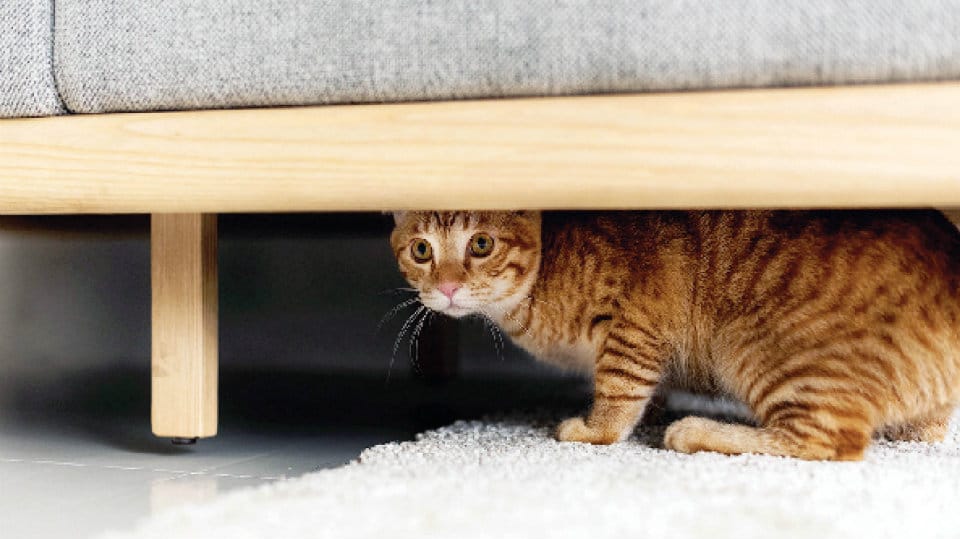In this week’s Pet Talk, Maneka gives tips on what has to be done to make the adopted dog / cat comfortable at its new home
By Maneka Gandhi
I recently adopted a dog but he is very shy. What should I do?
Designate a small, quiet room for your dog. Place the food, water, and bedding in the room. Travelling, having parties, or introducing your dog to a lot of new people who are not part of your household is not recommended at this time. Establish a regular feeding, sleeping and walking routine. Do not push the dog to do anything that will make him uncomfortable. Spend quiet time with the dog, perhaps just sitting and reading a book while in the same room. To gain trust, sit and pet the dog while giving him some treats. If the dog is uncomfortable being petted, then just try to offer treats, or try playing with him.
What should I do when I find a lost pet?
Call an animal protection group or a NGO. Call the Police to inform them about the found pet. They might have missing reports regarding that pet.
Check if the dog is wearing a tag or a collar, call the number and leave a message.
Take the dog to a local vet. The owners may have complained there.
Make a found poster and place it around the area.
Let the pet stay with you until a home is found. Abandoned, lost animals die very easily on the road as they have no idea where to find food.
What is the scope of Pet Insurance in India?
India has Pet Insurance Scheme wherein dogs between the ages of 8 weeks to 8 years can be insured at the basic rate of premium, which is 5% of the sum insured.
Pet Insurance covers: Death due to accident; Illness contracted while the policy is in effect; Treatment expenses; Accident while in transit (via rail, air or road); Loss/ theft of the pet; Incapacitation; Accidental poisoning; Third party liability.
Pet Insurance exclusions: Wilful or malicious injury to the pet; Injury or illness arising out of neglect or unskilful handling of the pet; Loss or injury due to war, foreign hostility, revolution, rebellion, military upheaval, etc.; Death due to rabies, distemper, viral hepatitis, viral enteritis, leptospirosis, etc.; Illness that has been contracted prior to taking the policy.
I recently adopted a cat but she is very shy. What should I do to make her feel more welcome?
Go slowly at first. A new cat may need seven to fourteen days to relax into her new environment.
Offer her a safe place to hide while she gets her bearings. She’ll appreciate the chance to observe her new family’s routine from a small, dark space, or one high above the action.
Take your cat to a caring veterinarian for a wellness exam within one week after adoption.
Provide the same diet she had at the shelter at least for the first week or two.
Cats must scratch, so make sure to provide yours with a sturdy, rough-textured scratching post to save wear and tear on furniture.
Cat-proof your home before giving your new feline run of the house. Put away harsh cleaning products, human medications and household poisons. Re-home any poisonous house-plants.
What are the human diseases that are contagious to dogs?
Mumps is a highly contagious viral disease in people. Initial physical symptoms of the disease include lethargy, muscle pain, headache, and fever, and are usually followed by a painful swelling of the parotid salivary glands, located on the sides of the face. Most dogs recover from a mumps infection in five to ten days. It is obviously best to keep your pets away from any infected family members.
Ringworm is an infection of the skin that affects humans as well as animals. Despite its name, ringworm is not caused by any type of parasite or worm but by a fungus. The primary symptom of ringworm in people is an itchy, round rash. In dogs, ringworm typically causes roughly round patches of hair loss that may or may not be itchy. Ringworm can be transmitted through direct contact with an infected individual (human or animal) as well as through contaminated objects (brushes, towels, etc.).
While Salmonella is often associated with food poisoning, it can also be passed to humans through contact with infected animals, and vice versa. In both humans and dogs, Salmonella can cause nausea, vomiting, diarrhoea, fever, headaches, and abdominal cramps. Dogs are more resistant to Salmonella than are people, so the chances of you making your dog sick are slim.
Why is my cat afraid of water?
Even though many cats love the taste of fish, they are not ocean or river dwelling creatures historically. The domesticated cat is the descendant of felines that typically live in dry arid areas. They have never learned to swim because there was no evolutionary need for it.
Cats ears are really small and if water gets inside, it will be almost impossible to get it out, creating deafness and possibly an infection.
Cats have an undercoat which does not dry easily. It’s like wearing a wet T-shirt for hours, making it hard for them to return to a dry, warm state quickly. Cats are also used to feeling nimble — in water, their motions become sluggish. Also, because cats are sensitive to odours, it’s possible your cat doesn’t like the scent of chemicals from tap water.
I recently adopted a new kitten. What should I do to make my resident cat bond well with her?
Here are five steps to follow when it comes to introducing your new kitten to your resident cat:
It is not advisable to bring your cat home and immediately introduce it to your resident cat. You need to have a safe room – a room like a bedroom that preferably has a bathroom attached to it. The kitten should be placed in that room with its toys, bed, litter box and food where your resident cat doesn’t sleep every night and also one where your kitten can get used to a human in the house.
The safe room allows your kitten to get used to the sounds and smells of your home, and allows your resident cat to get used to the smells of a new cat without the threat of it. Keep the kitten in the safe room for 1-2 weeks. During those 1-2 weeks the kitten will stop smelling like the shelter or breeder it came from, and will rather start smelling like your home, which is less threatening to your resident cat. It will also allow for the kitten to be cleared health wise to make sure s/he is not bringing home any diseases to your resident cat.
It is important to allow both the new kitten and your cat to get used to each other’s scents. To start off the process, take a soft cloth, or a clean sock, and wipe it around the new kitten’s face, under the chin, ear to ear, where some of the scent glands are located. Once you have the scent on the towel, offer it to the kitten or cat and do the same with the opposite.
Once the kitten’s health has been cleared by a vet, you can take the kitten from the safe room (maybe about the first week, depending on how curious your kitten is) and put your resident cat in the safe room for an hour. Allow the resident cat to smell the entire room, use the litter box, eat the kitten’s food (assuming your resident kitty has no health issues) and more. Meanwhile, do the same with the kitten — allowing her/him to explore the rest of the house.
Facilitate a face-to-face meeting. You can do this a few ways. You can put up a baby gate in the doorway of the safe room and allow the kitten and resident cat to approach each other in their own time. Or, you can put the kitten in a carrier that smells like your resident cat, and then bring the kitten in the closed carrier into the resident cat’s area and set it down. Allow the resident cat to approach the carrier in his or her own time—smelling, hissing, etc.
Once the cats seem to be calm at the sight of each other, it is probably safe to introduce the two without barriers like the pet carrier and baby gate. Make sure that they are supervised during this initial meeting. If there are any problems during this time, go back a step to allow each cat more time to view each other on opposite sides of the baby gate.
It is best to have one person hold the kitten and another hold the resident cat — preferably the person that the resident cat is most comfortable with. If the cats do well for a short time at a great distance, the next day repeat the process by decreasing the distance between them by a foot or two and increase the time they have to check each other out. On the first day, start about 10 feet apart for 5 minutes, the next day try 8 feet apart for 10 minutes and so on.








Recent Comments